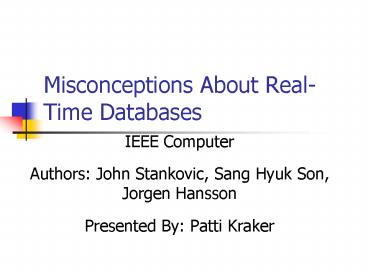Misconceptions About Real-Time Databases - PowerPoint PPT Presentation
1 / 23
Title:
Misconceptions About Real-Time Databases
Description:
Misconceptions About Real-Time Databases IEEE Computer Authors: John Stankovic, Sang Hyuk Son, Jorgen Hansson Presented By: Patti Kraker – PowerPoint PPT presentation
Number of Views:73
Avg rating:3.0/5.0
Title: Misconceptions About Real-Time Databases
1
Misconceptions About Real-Time Databases
- IEEE Computer
- Authors John Stankovic, Sang Hyuk Son, Jorgen
Hansson - Presented By Patti Kraker
2
Definitions
- Real-time database is a database system
- Queries
- Schemas
- Transactions
- Concurrency control support
- Storage management
3
Definitions
- Timing constraints associated with transactions
- Not every transaction, but some
- Data valid for specific time intervals
4
Definitions
- Time semantics on data
- E.g. sensor data, stock market prices
- Semantics indicate valid for certain time period
- In a real-time database
- Validity interval part of database schema
5
Definitions
- Transaction Correctness
- Absolute time consistency
- Individual data is temporally valid to acceptable
degree of accuracy - Relative time consistency
- Multiple data items updated within specified time
interval of each other - E.g. time and pressure
6
Misconceptions
- Real-time systems synonymous with speed
- Current database technology can be used in
real-time database systems
7
Misconceptions/Research
- Real-time database properties temporality,
predictability, specialization - Research areas for real-time databases
8
Real-time systems synonymous with speed
9
Hardware advances
- Hardware advances will address real-time database
requirements - Parallel processing
- Does not mean meet timing constraints
- Inc. size and complexity
- Hardware alone not ensure data accurate
10
Hardware advances
- Sum up hardware advances
- Transaction that uses obsolete data more quickly
is still incorrect
11
Advanced DB technology
- Advancing Standard Protocols
- Better buffering, faster commit protocols, better
query processing - Can not guarantee deadlines or valid data
- Required advances include
- time cognizant protocols, commit processing
- transaction scheduling, logging, recovery
12
Advanced DB technology
- Sum up advanced db technology
- These protocols better at supporting real-time
transaction and data correctness than standard
database protocols that simply go fast.
13
Real-time Fast
- Fast computing Aim to minimize response time of
transactions - Real-time computing Aim to meet timing
constraints and data validity of transactions and
keep database current - Need time cognizant protocols
14
(No Transcript)
15
Current DB technology can solve real-time problems
16
Traditional databases
- Traditional databases can handle real-time
- Can define field that contains validity interval
- Every transaction must check this field to ensure
absolute and relative validity - Can run earliest deadline scheduling through
priority of transaction
17
Traditional databases
- By adding those features, moving toward real-time
db - More efficient to build them into system than
force fit traditional db
18
Db in main memory
- Placing a conventional database in main memory is
sufficient (non-real-time db designers) - Does eliminate disk delays
- Still unpredictable
- Delays due to blocking on locks
- Transaction scheduling
- Stolen processing time to handle external
interrupts
19
Db in main memory
- Sum up current db technology
- Increases in performance can not completely make
up for lack of time-cognizant protocols
20
Real-time DB in main memory
- A real-time db must reside totally in main memory
(real-time db designers) - Reasons to increase speed, avoid seek and
rotational delays of disks - Primary issue I/O
- Minimize response time, maximize throughput,
maintain fairness - Typical disk scheduling algorithms are
First-Come-First-Served (FCFS),
Shortest-Seek-Time-First (SSTF), etc.
21
Real-time DB in main memory
- Sum up real-time db in main memory
- Since deadline and importance of transaction are
not considered when disk request are scheduled,
timeliness of transaction is jeopardized.
22
Start of real-time databases
- Real-time databases emerged from
- Telecommunications, manufacturing, and avionics
applications - Conventional databases not adequate
23
Research of real-time db
- Increased audio and video applications
- More research problems being addressed































